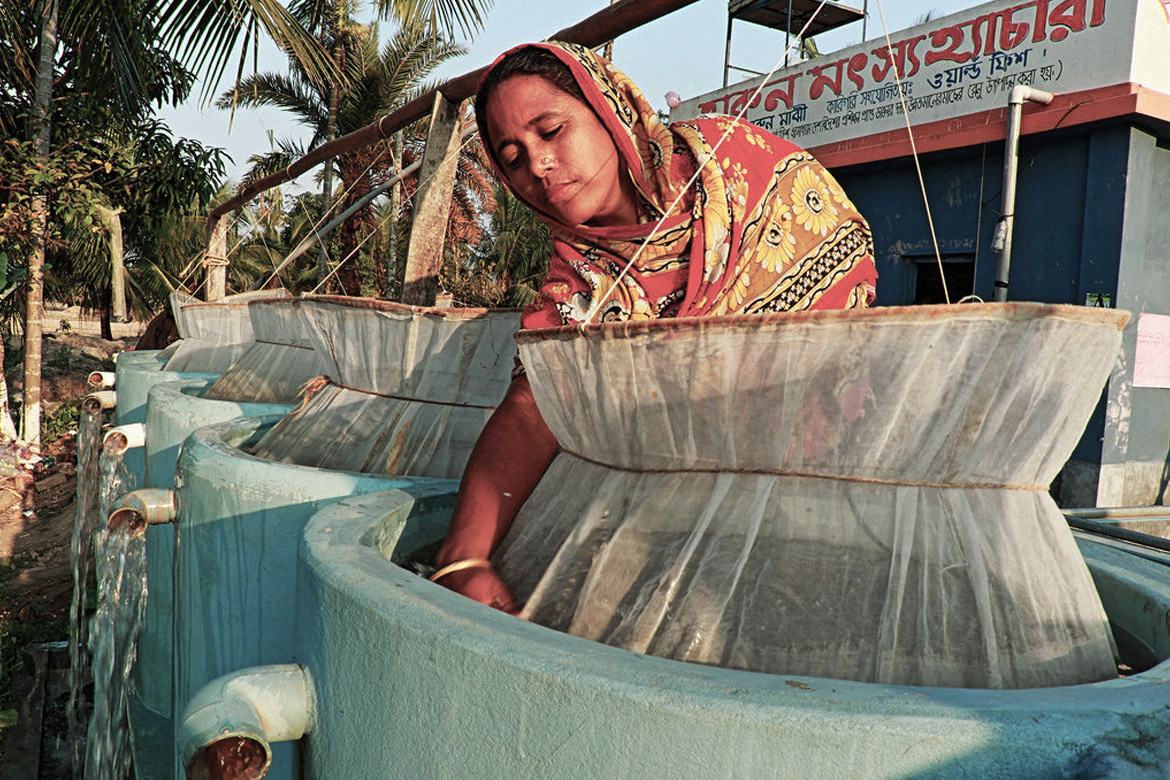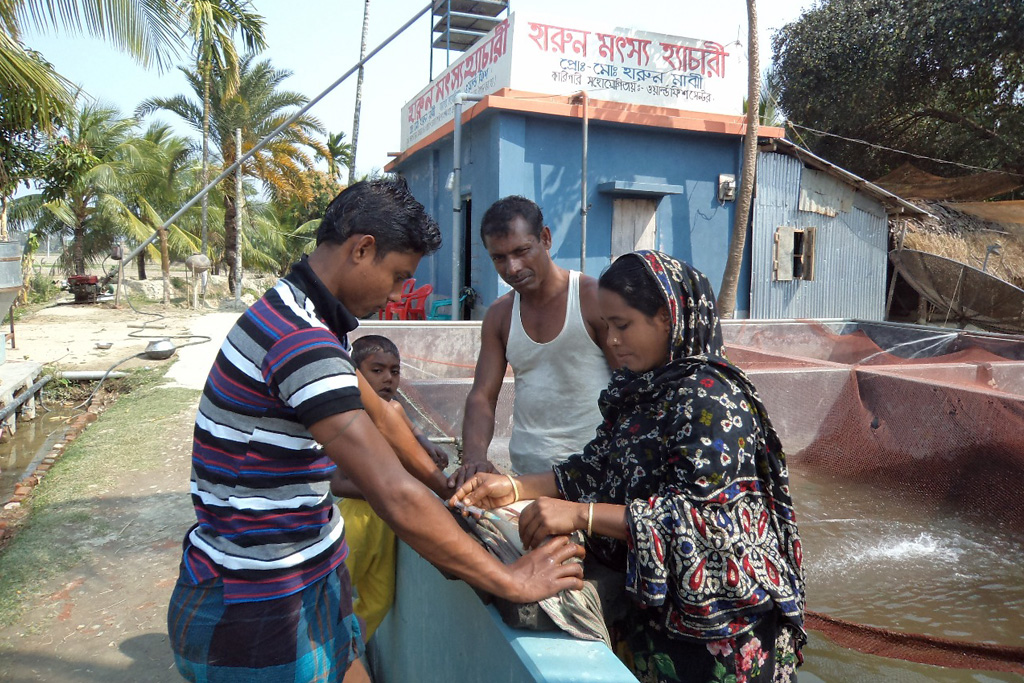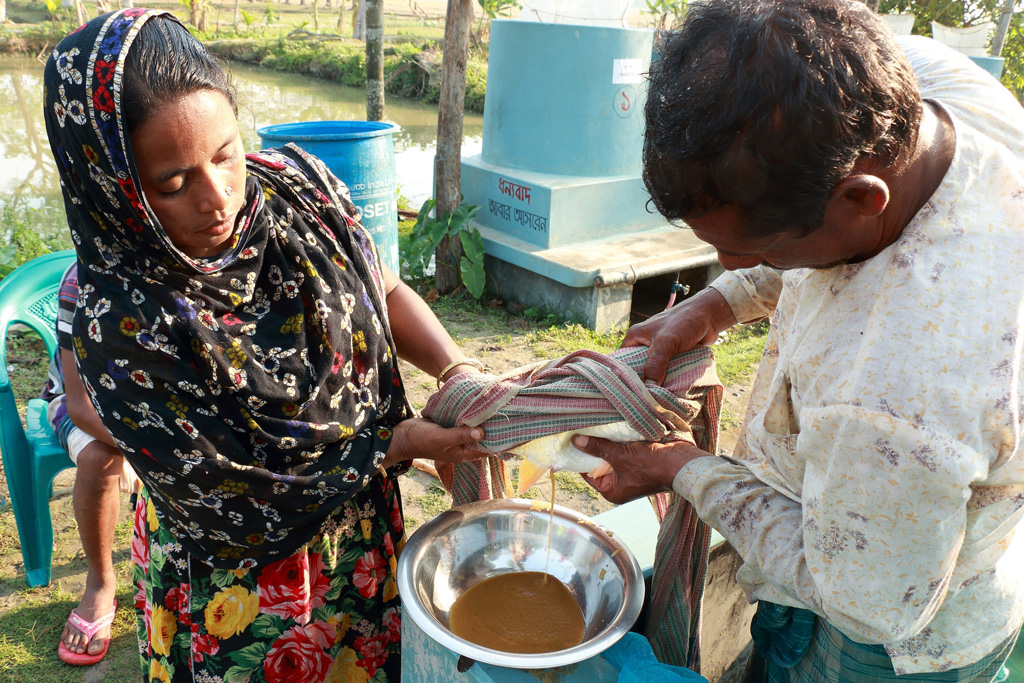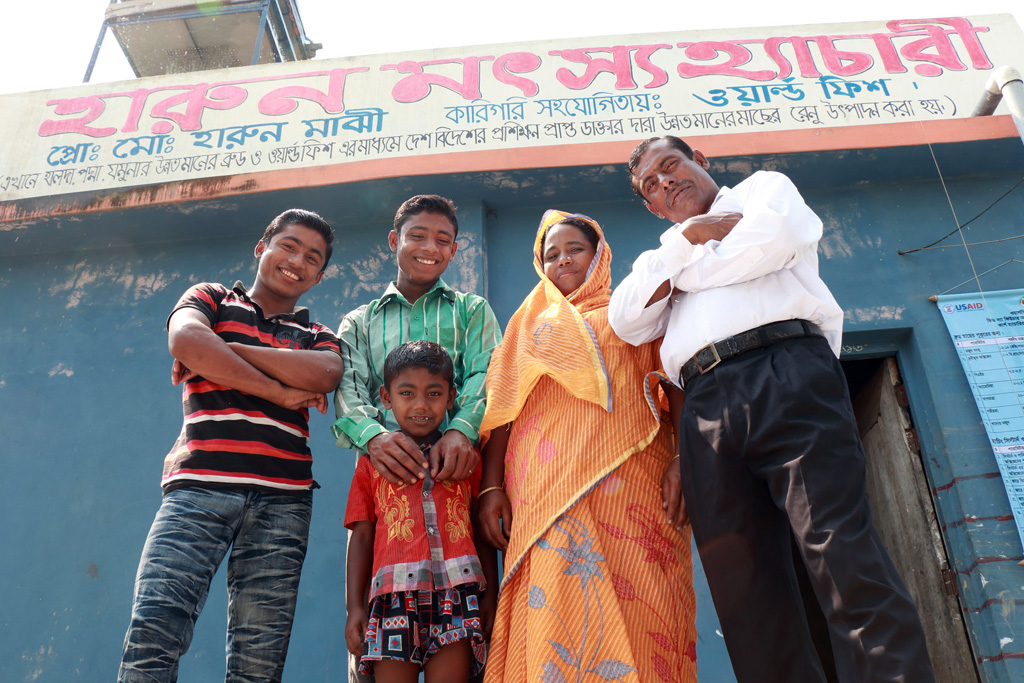-

Bina’s success story:
From day laborer
to hatchery owner
Today, Bina Majhi runs a thriving fish hatchery business in Hajipur, Bangladesh. But it’s been a bumpy 20-year journey for the former day laborer, who credits her success to support and training received from WorldFish projects.
In 2007, cyclone Sidr swept through Bangladesh, leaving a trail of destruction. For Bina Majhi and her husband, the cyclone destroyed their fish hatchery business in an instant, and with it, their primary source of income.
“I lost everything. My capital, hope, dreams... everything. I never thought that I would be able to run my business again,” says Bina from Hajipur village, Patuakhali district. Left with no resources or equipment, Bina and her husband were forced to close the hatchery, which they had worked for 10 years to establish.
From day laborer to businesswoman
From 1992 to 1996, Bina and her husband worked in the fields and in a hatchery as day laborers. But the little pay they received made it hard to bear the family expenses.
Looking for a way to increase their earnings, they started selling fingerlings they had bought with the little extra income they had saved. The next year, in 1997, Bina started a nursery pond with hatchlings she had bought from a nearby hatchery. It was the beginning of her hatchery enterprise.

Bina at work in the fish hatchery she runs with her husband in Hajipur village, Patuakhali district. Photo by AWM Anisuzzaman/WorldFish
A few years later, in 1999, Bina joined the DANIDA-supported Patuakhali Barguna Aquaculture Extension project, which promoted integrated fish and vegetable farming, and received training from them. Despite this, she lacked the capital and equipment needed to put her new knowledge into practice. “I had to sell all of the ornaments from my wedding ceremony to buy the brood fish and equipment for my hatchery,” she says.
Over the next five years, she was able to grow the business and make enough money to cover family expenses. Then in 2005 disaster struck and a poisoning incident saw all the fish in the nursery pond lost. This was followed, in 2007 by cyclone Sidr, which washed away everything, leaving Bina and her husband no option but to completely shut down the business.
Restarting her business
Five years passed before they could rebuild the business, with the technical help of the WorldFish-DANIDA-initiated quality seed project. Then in 2013, the hatchery received support from the USAID-funded and WorldFish-led Aquaculture for Income and Nutrition (AIN) project. The project aims to increase the productivity of fish farms and improve the lives of millions like Bina and her family through better health and financial security.
My husband can rely on me to manage the hatchery even in his absence – hatchery owner Bina Majhi
As part of the project, she received quality broodstock, hatchery equipment, operational and promotional materials, training and technical assistance. Bina and her husband also received training in nursery management, quality fish spawn production, feed and brood management, brood rearing and breeding techniques. She learned how to inject hormones into the carp broodstock to release matured eggs and milt (semen of a male fish).

Bina injects hormones into the fish, a skill she learned in training provided by the AIN project. Photo by AWM Anisuzzaman/WorldFish
Through the training sessions, Bina was connected with fish farmers participating in other projects including the Nobo Jibon Multi Year Assistance Program and the Cereal Systems Initiative for South Asia in Bangladesh (CSISA-BD).
The training enabled her to become a successful hatchery owner, a world away from her experience as a day laborer working in a hatchery. “It was really challenging for me to work with my husband in a hatchery, back when we used to work as day laborers. The people of the hatchery didn’t want to allow me inside where my husband used to work,” she explains.
“When we finally started our own hatchery, people condescendingly called it a bou hatchery [a hatchery owned by a wife]. The entire village was against me. However, training on aquaculture from WorldFish’s AIN project and mental support from my husband gave me the power to fight against the situation,” she says.

Bina and her husband collect eggs from a female silver carp. Photo by AWM Anisuzzaman/WorldFish
A bigger business
Since implementing the techniques learned in training, Bina has seen her production and sales grow every year. In 2014, Bina and her husband also started producing and selling fingerlings, which boosted their sales further.
Year |
Fish spawn production |
Fish spawn sales |
Fingerling production |
Fingerling sales |
2012 |
200 kg |
BDT 499,200 |
n/a |
n/a |
2013 |
238 kg |
BDT 561,600 |
n/a |
n/a |
2014 |
294 kg |
BDT 1,000,584 |
150,000 |
BDT 200,070 |
2015 |
324 kg |
BDT 1,116,200 |
610,000 |
BDT 130,000 |
2016 |
586 kg |
BDT 1,257,250 |
1,200,000 |
BDT 280,000 |
Using the profits, Bina and her husband have expanded their business. Since 2012, they have added four new ponds for nursing and breeding, a concretetank and oxygen tower, and have invested in purchasing more broodstock. With financial support from the project, they were able to purchase 300 kg of Indian Major Carp, Rui and Mrigel broodstock to reinvest in the hatchery. This option was offered by the AIN project, which contributed 70% of the cost, to all interested hatcheries in the region.
Bina attributes the growth of her business, which continues to attract new farmers, to her friendly approach, quality service and communication with other nursery managers. Demand for spawn in the district sub-unit, known as an upazila, is high and continues to increase, meaning Bina and the other two hatcheries in the upazila have further opportunity to expand.

Bina and her husband with their three sons at their fish hatchery. Photo by AWM Anisuzzaman/WorldFish
Recently, Bina and her husband joined one of the newly-formed quality seed groups, an alliance of local fish nursery owners, seed sellers and hatcheries. The AIN project established these groups to bring together actors in the fish seed value chain, which if they buy from each other, enables greater traceability.
As an accomplished businesswoman and fish farmer, Bina is well respected by her community. Now, she receives many social invites, offers to attend school committee meetings and is the vice president of a local community-based organization. She continues to share her knowledge with many in the community, stating, “many neighboring farmers come to me for advice because of my technical knowledge and success.”
Project
Aquaculture for Income and Nutrition (AIN)Donor:
USAIDPartners:
Community Development CenterSociety for People's Education, Empowerment and Development Trust
Bangladesh Shrimp & Fish Foundation
Bangladesh Fisheries Research Institute
Department of Fisheries, Bangladesh
Related sustainable development goals



Tags
Asia, Bangladesh, small-scale aquaculture, fish farming, sustainability, training, livelihoodsgenderImpacts
kg of fish spawn produced by Bina’s business in 2016
BDT worth of fish spawn sold by Bina’s business in 2016
fingerlings produced by Bina’s business in 2016
BDT worth of fingerlings sold by Bina’s business in 2016
Related publications
Photo credits - WorldFish.

